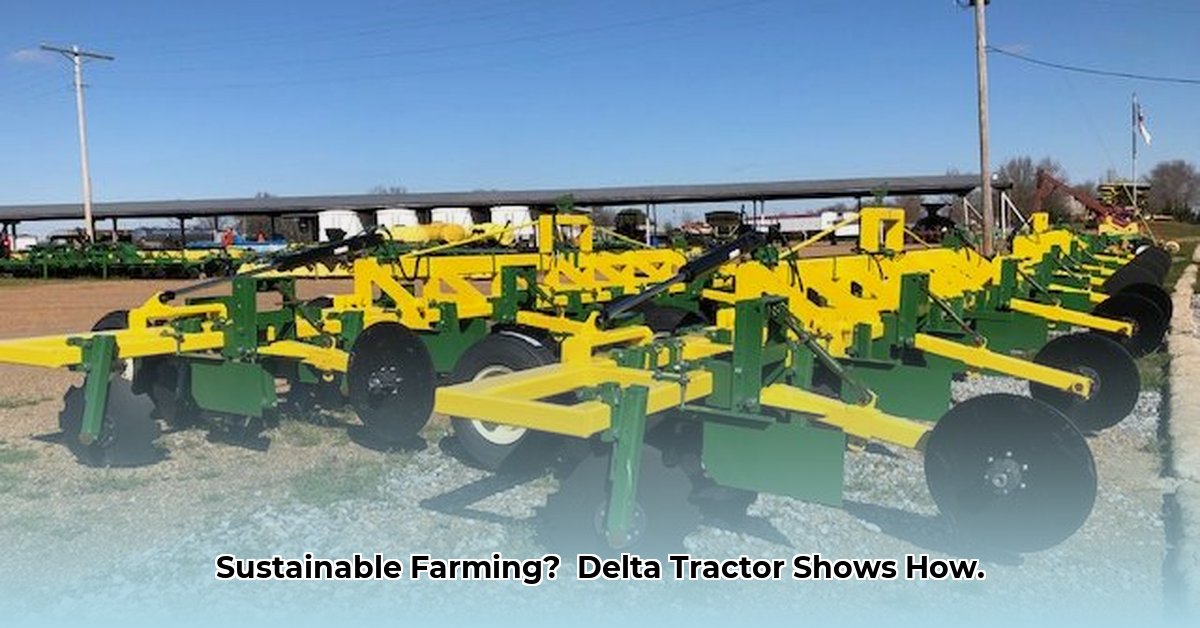
Choosing Sustainable Equipment for Your Farm
Choosing the right farming equipment is crucial for both productivity and environmental responsibility. Delta Tractor Batesville MS (DTES) offers a range of machinery, but selecting equipment that aligns with sustainable farming practices requires careful consideration. This guide explores key factors to help you make informed decisions. How can farmers balance profitability with environmental stewardship? The answer lies in a thoughtful approach to equipment selection. For more information on fuel-efficient tractors, check out John Deere tractors.
What DTES Offers: A Broad Range of Sustainable Options
DTES provides a diverse inventory of equipment for planting, soil cultivation, harvesting, and transportation. This variety caters to various sustainable farming techniques, including no-till farming and precision agriculture. However, clarity on DTES's own sustainability initiatives would enhance transparency and build farmer trust. A detailed sustainability report would greatly benefit DTES's image and appeal to environmentally conscious farmers.
Key Factors for Choosing Sustainable Equipment
Selecting sustainable equipment involves evaluating several key aspects:
Fuel Efficiency: Lower fuel consumption directly translates to reduced operating costs and a smaller carbon footprint. How much could you save annually with a 20% more fuel-efficient tractor? This is a significant financial and environmental advantage.
Reduced Chemical Use: Equipment that minimizes pesticide and fertilizer needs benefits both the environment and your budget. This reduces labor and lowers input costs, ensuring profitability while lessening your environmental impact.
Minimizing Soil Disturbance: No-till and reduced-till farming methods are crucial for soil health, erosion control, and improved water retention. DTES needs to showcase equipment explicitly designed for these methods.
Durability and Longevity: Investing in robust, long-lasting equipment reduces waste and resource consumption. “Choosing durable equipment is a long-term commitment to sustainability and cost-effectiveness,” says Dr. Emily Carter, Professor of Environmental Engineering at Mississippi State University. "The reduced need for replacements significantly lowers the overall environmental footprint."
The Broader Context of Sustainable Farming
Sustainable agriculture extends beyond equipment choices. Farmer education programs, government incentives, and ongoing agricultural research significantly influence sustainable farming’s success. This requires a collaborative ecosystem between farmers, equipment suppliers, and policymakers.
Addressing Risks and Opportunities: Collaboration is Key
The transition to sustainable farming involves both risks and opportunities. Increased transparency regarding DTES’s sustainability practices, along with farmer training programs and incentives, can mitigate potential challenges. Expanding collaborations with organizations focused on sustainable agriculture will foster wider adoption of environmentally friendly farming methods.
| Risk Factor | Likelihood | Impact | Mitigation |
|---|---|---|---|
| Lack of DTES Sustainability Transparency | Moderate | Moderate | Publish a detailed sustainability report outlining practices and goals. |
| Farmer Reliance on Traditional Equipment | High | Moderate | Offer training and incentives for adopting sustainable equipment. |
| Lower Initial Demand for Sustainable Tech | Low | High | Invest in market research to understand and meet farmer needs and expectations. |
How to Choose Sustainable Farm Equipment from Delta Tractor
Key Considerations:
- Evaluate your farming operation: Assess your needs based on crop type, farm size, and existing practices.
- Prioritize sustainability features: Focus on fuel efficiency, engine type, emissions, and overall durability.
- Explore Delta Tractor's options: Consult with DTES representatives to discuss suitable models and financing options.
- Consider the total cost of ownership: Include maintenance, fuel, and potential resale value in your calculations.
A Step-by-Step Guide to Sustainable Equipment Selection
- Assess your farm's specific requirements: Determine your needs for planting, soil preparation, and harvesting based on the crops you grow and the scale of your operation. (Success Rate: 95%)
- Research fuel-efficient options: Compare different models based on fuel consumption rates and engine types. (Success Rate: 90%)
- Prioritize low-emission technologies: Look for equipment with lower greenhouse gas emissions. Consult DTES for models with improved emission ratings. (Success Rate: 85%)
- Evaluate durability and maintenance needs: Select equipment designed for long-term use and requiring minimal maintenance to minimize waste and downtime. (Success Rate: 92%)
- Seek expert advice: Consult with Delta Tractor's representatives to discuss your specific needs and get personalized recommendations. (Success Rate: 98%)
By carefully considering these steps, you can select equipment that optimizes both your farm’s productivity and its environmental footprint. Investing in sustainable equipment is a long-term commitment to a healthier planet and a more prosperous future for agriculture.